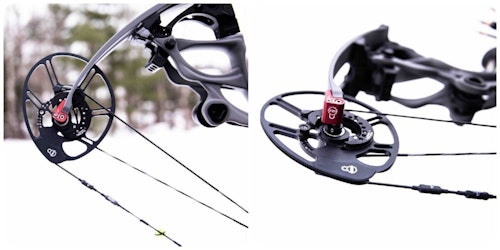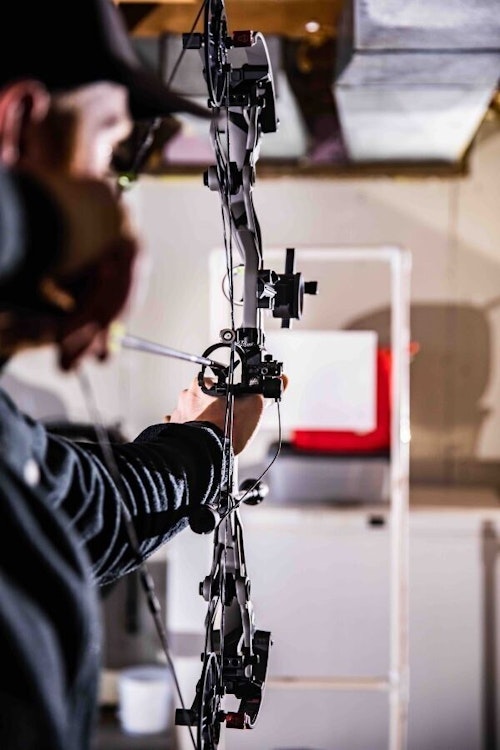
Target acquisition and aiming felt nearly effortless to the author. A fairly straight riser, high let-off and wide riser ends, pockets and limbs contribute to the stability.
Carefully, I studied the bedded muley buck until I understood his anatomy given the complex shot angle. He was faced almost directly away from me. Unbeknownst to him, I was perched like a hawk on an embankment directly above him.
A variable crosswind escalated the 22-yard shot’s complexity, my sight pin inadvertently floating on and off his vitals as I aimed steeply downward. I timed it just right, and my arrow hit home. He sprang and bolted out of view. Immediately, I hustled 100 yards to reacquire him. When I did, the buck was already bedded down and likely moments from his fate, but I delivered another arrow just to be sure.
Bowtech’s inaugural carbon offering, the Carbon Knight, helped me 10-ring that buck twice and take two other deer that same season. It was my favorite bow in 2013, and I shot it very accurately out to 80 yards. Bowtech followed up with a few more carbon models such as the Carbon OverDrive, Carbon Icon and Carbon Zion — all strong performers constructed similarly to the Carbon Knight.
But, Bowtech has reimagined carbon, and its latest carbon unveiling is technologically leaps and bounds ahead of all previous models. To that end, meet the Carbon One.
Test Bow Specs
- Axle-to-Axle Length: 30 inches
- Brace Height: 6.63 inches
- Draw Length: 28 inches
- Draw Weight: 69.8 pounds, Comfort; 70.2 pounds, Performance
- Let-off: 87%, Comfort; 85%, Performance
- Bow-only Weight: 4.5 pounds
- Accessorized Total Weight: 6.5 pounds (no quiver)
- Velocity: 264 fps, Comfort; 272 fps, Performance (with 468-grain Easton 6.5mm Acu-Carbon 340 arrow)
- Kinetic Energy: 72.41 foot-pounds, Comfort; 76.87 foot-pounds, Performance
- Test-Bow Finish: Smoke Grey
- MSRP: $1,799 (starting price)
- Contact: www.bowtecharchery.com
First Impressions
While Bowtech’s previous carbon models were attractive, the Carbon One delivers a new look that truly epitomizes the future of carbon-bow aesthetics. The cutout-free center of the aerospace-inspired carbon riser flows into a series of captivating curves and bridges at both ends. Aesthetically, it’s a masterpiece, but the design isn’t just for looks.
The bridges occur at vital points in the riser where strength is critical: near and at the pocket connections. Bowtech’s previous carbon models had relatively thin connection points because the risers were thinner. The Carbon One’s pocket connection is much stabler, connecting with the ultra-dependable Dual Lock pockets at four separate points on each end, advancing strength, balance and stability.
I’ve tested and hunted with several carbon bows in my hunting and writing career. Each time I do, I’m reminded how nice it is to grip them in cold weather. While testing the Carbon One after Christmas in my ice-cold Wisconsin backyard — true hunting weather for many rut and late-season bowhunters — my hand wasn’t sapped of warmth as it is with machined-aluminum bows.
Speaking of the grip, the Clutch Performance Grip defines comfort. Archers with bear-paw hands might find it on the small side, but it’s tailored perfectly for average-sized mitts like mine or smaller. Shot after shot, I fell in love with how naturally the Clutch fits my hand. In fact, I’m rating it among the best available.
Since we’re still on the riser, four tactical finishes truly complement the futuristic riser design. It isn’t available in any camo finishes, but let’s face it, solid colors are all the rage now. The Smoke Grey finish on my Carbon One is sharp as a tack, and the Black, Flat Dark Earth and OD Green finishes are bad — in a good way — too.

It’s Got Options
One of Bowtech’s greatest technology wins is its sensational DeadLock Cam System, and it’s the Carbon One’s engine. If you’re a Bowtech dealer, you know exactly how it works. If you aren’t, let me explain it.
Moving the cams left or right on the axle for tuning is as simple as loosening the locking screw, adjusting the tuning screw, and then tightening the locking screw. This eliminates the need for split buss cables and finicky tuning. It speeds the tuning process for you, the dealer, and it puts the capability within your customer’s reach with no bow press required.
The FlipDisc feature on the Rotating Module provides two unique draw cycles. For those seeking the smoothest draw cycle that money can buy, the Comfort draw cycle is it. I’ve felt nothing smoother. When I flipped the FlipDisc to Performance, it was still fairly smooth, but with a steeper hump before rolling into the valley. I did gain 8 feet per second of arrow velocity. I did my share of shooting in both settings and definitely see each one’s merits. I also noticed that the dual cable stops produce a positive back wall, which I love.
Located at each end on the back of the riser are multiple threaded accessory mounts to accommodate weights, silencers and stabilizers, giving your customers the flexibility to achieve an individualized balance. Speaking of accessories, a continuous metal mounting plate inlaid into the riser provides rigid connections for the bowsight, FLX Guard and either a conventional arrow rest or Integrate-compatible arrow rest. Conventionally mount a quiver to the sight bracket, or utilize the included adapters to mount a Bowtech two-piece quiver to the attachment points through the Orbit Dampeners.

It’s Got Performance
The Carbon One’s shooting performance matches its flawless aesthetics. I was quickly drilling bull’s-eyes at 20 yards, and then I did some homework with my new Dialed Archery Arxos sight since it’s second and third pins are fixed. My middle pin was on at 33 and my bottom pin at 47 yards. For me, the Carbon One delivers repeatable accuracy at those distances, and I expect the same results when I spend some time shooting it at 80, 90 and 100 yards this spring when the weather warms up.
Nearly effortless target acquisition really stood out in my mind. High let-off, a straight riser design and the widened riser ends and wide limb stance are attributes that cultivate this level of awesome. I expect that your customers will notice and appreciate this immediately.
The market has faster bows, but the Carbon One is no slouch, especially given a forgiving 6.63-inch brace height. My Easton 6.5 Acu-Carbon 340 arrow weighs a stout 468 grains and leaves the bow at 272 feet per second with the FlipDisc set to Performance, and kinetic energy is 76.87 foot-pounds — ideal for all North American big game.
Aptly positioned Orbit Vibration Dampeners address vibrations in the riser before they reach the shooter’s hand, resulting in a silky-smooth shooting experience. The One doesn’t include limb or bowstring dampeners — maybe it should since it retails for $1,799. It shoots surprisingly smoothly and quietly without them, though adding them would ice the cake for perhaps the market’s quietest, most vibration-free shot.
Final Thoughts
The initial carbon craze was centered around diminished mass weight. You might recall that the Carbon Knight weighed merely 3.75 pounds. The Carbon One is slightly heavier at 4.5 pounds, but we must compare the weight difference objectively. The wider pocket, riser ends and limbs maximize strength and stability. A similar riser design constructed of machined aluminum would likely tip the mass weight to more than 5 pounds. So, the Carbon One is still lightweight considering its robust construction. Plus, the additional weight makes it noticeably stabler than Bowtech’s previous ultra-lightweight carbon models.
To conclude, ponder this: Why would your customers spend $1,799 on the Carbon One? Well, the materials are on-point. The craftsmanship is on-point. The options are on-point. The comfort is on-point. The performance is on-point. The future of carbon bows is here, and I believe your high-end customers will consider their money well-spent when they take home their new Carbon One.
Additional Notes
The Bowtech Carbon One was set up using a Last Chance Archery EZ Green Bow Press and EZ Green Bow Vise, and draw weight was calculated using Last Chance Archery’s Digital Bow Scale. A Caldwell Ballistic Precision Chronograph measured the 468-grain Easton 6.5mm Acu-Carbon 340 arrow’s velocity. Other products used were Easton’s Nock and D-Loop Pliers and Pro Hex Fold-Up Allen Set.
In-the-field photos by Becca McDougal







